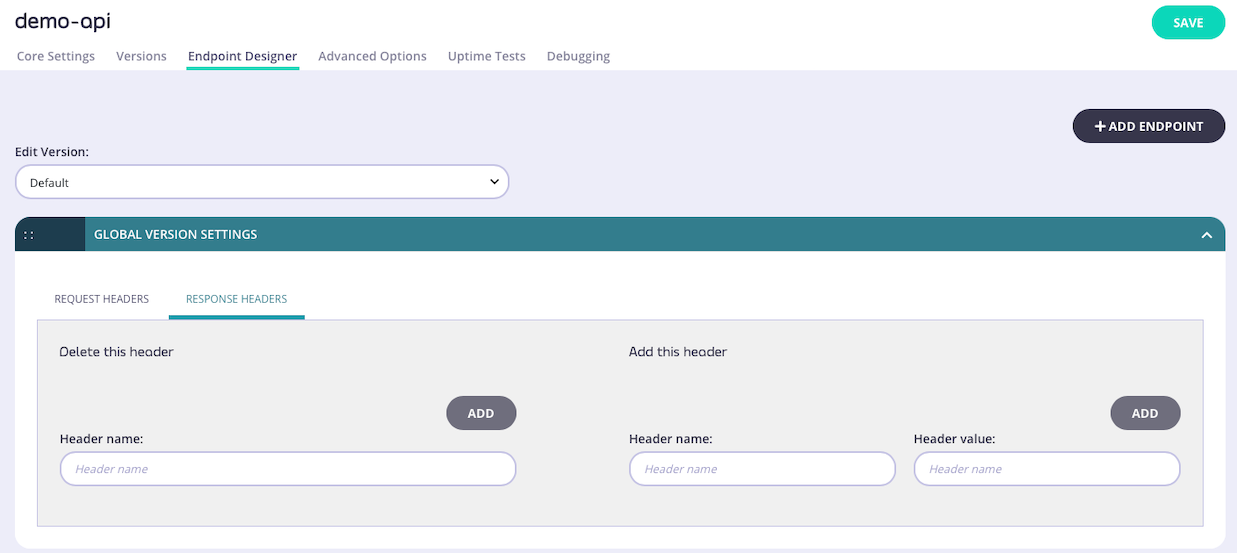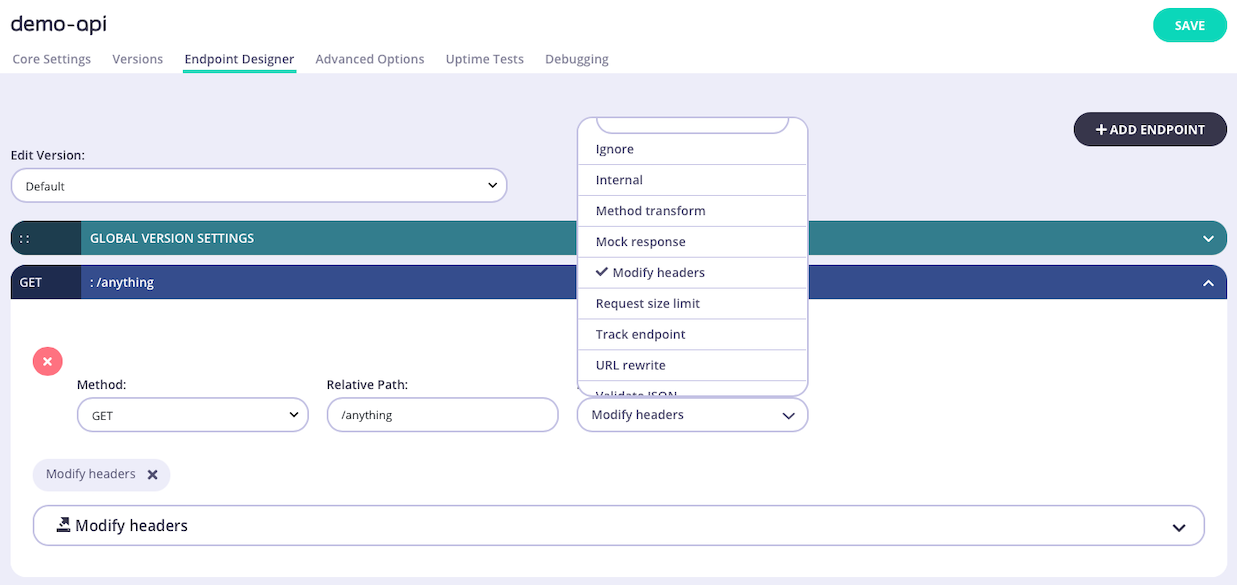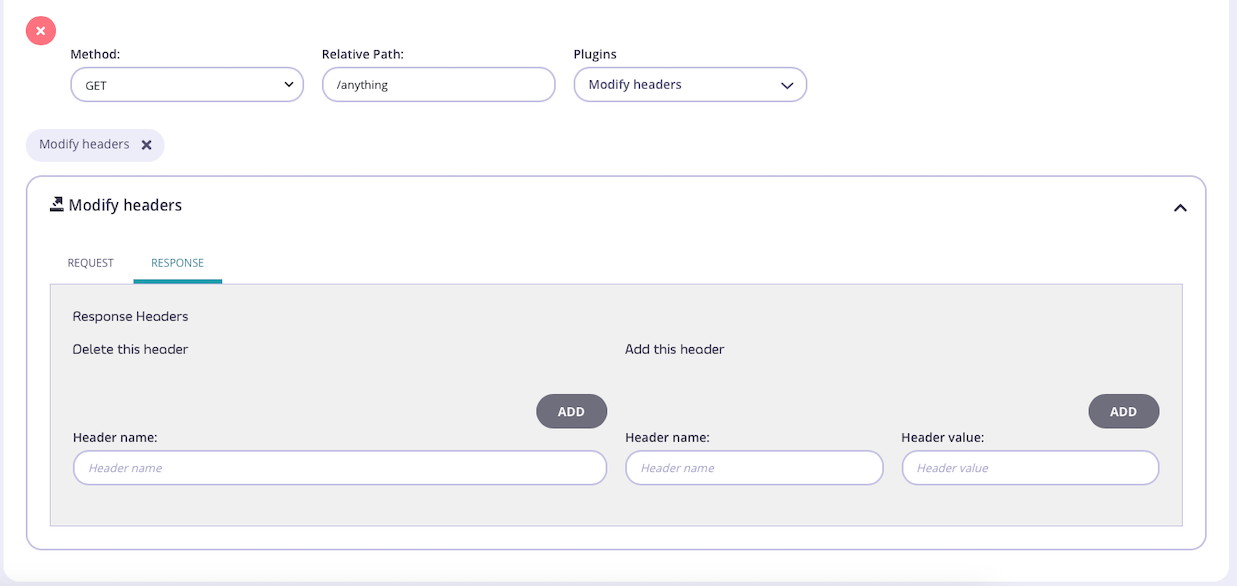Using the Response Header Transform with Tyk Classic APIs
Last updated: 5 minutes read.
Tyk’s response header transform middleware enables you to append or delete headers on responses received from the upstream service before sending them to the client.
There are two options for this:
- API-level modification that is applied to all responses for the API
- endpoint-level modification that is applied only to responses from a specific endpoint
Note
If both API-level and endpoint-level middleware are configured, the endpoint-level transformation will be applied first.
When working with Tyk Classic APIs the transformation is configured in the Tyk Classic API Definition. You can do this via the Tyk Dashboard API or in the API Designer.
If you want to use dynamic data from context variables, you must enable context variables for the API to be able to access them from the response header transform middleware.
If you’re using the newer Tyk OAS APIs, then check out the Tyk OAS page.
Configuring the Response Header Transform in the Tyk Classic API Definition
The API-level and endpoint-level response header transforms have a common configuration but are configured in different sections of the API definition.
Note
Prior to Tyk 5.3.0, there was an additional step to enable response header transforms (both API-level and endpoint-level). You would need to add the following to the Tyk Classic API definition:

{
"response_processors":[
{"name": "header_injector"}
]
}
If using the Endpoint Designer in the Tyk Dashboard, this would be added automatically.
We removed the need to configure the response_processors element in Tyk 5.3.0.
API-level transform
To append headers to all responses from your API (i.e. for all endpoints) you must add a new global_response_headers object to the versions section of your API definition. This contains a list of key:value pairs, being the names and values of the headers to be added to responses.
To delete headers from all responses from your API (i.e. for all endpoints), you must add a new global_response_headers_remove object to the versions section of the API definition. This contains a list of the names of existing headers to be removed from responses.
For example:
|
|
This configuration will add three new headers to each response:
X-Staticwith the valuefoobarX-Request-IDwith a dynamic value taken from therequest_idcontext variableX-User-IDwith a dynamic value taken from theuidfield in the session metadata
It will also delete one header (if present) from each response:
X-Secret
Endpoint-level transform
To configure response header transformation for a specific endpoint you must add a new transform_response_headers object to the extended_paths section of your API definition.
It has the following configuration:
path: the endpoint pathmethod: the endpoint HTTP methoddelete_headers: a list of the headers that should be deleted from the responseadd_headers: a list of headers, in key:value pairs, that should be added to the response
For example:
|
|
In this example the Response Header Transform middleware has been configured for HTTP GET requests to the /status/200 endpoint. Any response received from the upstream service following a request to that endpoint will have the X-Static header removed and the X-Secret and X-New headers added (with values set to the-secret-key-is-secret and another-header).
Combining API-level and Endpoint-level transforms
If the example API-level and endpoint-level transforms are applied to the same API, then the X-Secret header will be added (by the endpoint-level transform first) and then removed (by the API-level transform). Subsequently, the result of the two transforms for a call to GET /status/200 would be to add four headers:
X-Request-IDX-User-IDX-StaticX-New
Fixing response headers that leak upstream server data
A middleware called header_transform was added in Tyk 2.1 specfically to allow you to ensure that headers such as Location and Link reflect the outward facade of your API Gateway and also align with the expected response location to be terminated at the gateway, not the hidden upstream proxy.
This is configured by adding a new rev_proxy_header_cleanup object to the response_processors section of your API definition.
It has the following configuration:
headers: a list of headers in the response that should be modifiedtarget_host: the value to which the listed headers should be updated
For example:

{
"response_processors": [
{
"name": "header_transform",
"options": {
"rev_proxy_header_cleanup": {
"headers": ["Link", "Location"],
"target_host": "http://TykHost:TykPort"
}
}
}
]
}
In this example, the Link and Location headers will be modified from the server-generated response, with the protocol, domain and port of the value set in target_host.
This feature is rarely used and has not been implemented in the Tyk Dashboard UI, nor in the Tyk OAS API.
Configuring the Response Header Transform in the API Designer
You can use the API Designer in the Tyk Dashboard to configure the response header transform middleware for your Tyk Classic API by following these steps.
API-level transform
Configuring the API-level response header transform middleware is very simple when using the Tyk Dashboard.
In the Endpoint Designer you should select the Global Version Settings and ensure that you have selected the Response Headers tab:

Note that you must click ADD to add a header to the list (for appending or deletion).
Endpoint-level transform
Step 1: Add an endpoint for the path and select the Header Transform plugin
From the Endpoint Designer add an endpoint that matches the path for which you want to perform the transformation. Select the Modify Headers plugin.

Step 2: Select the “Response” tab
This ensures that the transform will be applied to responses prior to them being sent to the client.

Step 3: Declare the headers to be modified
Select the headers to delete and insert using the provided fields. You need to click ADD to ensure they are added to the list.

Step 4: Save the API
Use the save or create buttons to save the changes and activate the middleware.